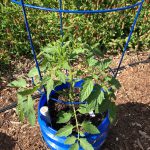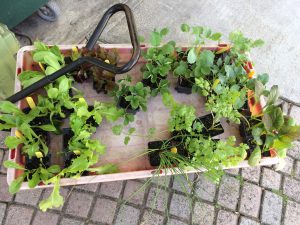Some of the many benefits of starting your own home garden are having fresher, more nutritious produce, the positive effects on physical and mental health, increased consumption of fresh fruits and vegetables and a potential cost savings. Also there are many advantages to starting a garden in the spring with transplants. You avoid bad weather, achieve earlier and higher yields, avoid insect and disease issues, and can choose the best and strongest plants to add to your garden.

Using a self-watering container is an excellent option if you find yourself away from the garden this summer. Photo by Molly Jameson.
Now is the time to start planting seeds indoors for warm season crops such as tomato, pepper, cucumber, eggplant, okra, summer squash, watermelon and many more. It is important to consider the number of days to harvest, planting zone, and location to plant. Buy seeds from a reputable source and check the expiration dates/sell-by dates and follow the packet.
When seeding the containers follow instructions for the seeding rates, spacing and depth on your seed packet. Smaller seeds can be broadcast over the surface and larger seeds will need to be covered with soil. Temperature and humidity are important for germination. Your packet will be specific on how deep to plant the seeds and a range of how long it will take to germinate. Label your container with the vegetable name and date seeded. You may find yourself like me and thinking you will remember what it is only to be guessing what you have as it germinates!
Most seeds started indoors will be ready for the garden in 4 to 6 weeks. Transplants must be hardened off first which means you should reduce the amount of water and stop fertilizing 1-2 weeks before they are ready to go into the garden. The seedlings will need a good bit of sun/light and moisture once they germinate to avoid leggy and stretchy plants.
The next step is to care for your transplants. As you have taken the time to seed them, watch them grow, and then put the plants into their new home it is important to set them up for success. Monitor the transplants for insect and disease on a weekly basis. Make sure the garden is free of weeds before the plants go into the ground. Weeds will fight for the same water and nutrients as the transplants. Transplant when the environmental conditions are best. This means to plant them in the morning, on a cloudy/overcast day, and when there is not a big storm in the forecast. When taking the little transplant out of the pot be careful to not disturb the roots and do not pack the soil around the roots.
If you have any questions on spring gardening please contact your local extension office for more information.
- Steps to Keeping a Healthy Lawn - March 30, 2023
- Companion Planting: What is it? - February 21, 2023
- Educational Opportunity: Fruit and Vegetable Meeting - December 22, 2022

